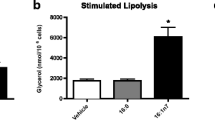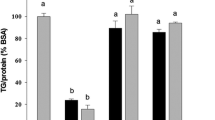Abstract
The ability of conjugated linoleic acid (CLA) to reduce adiposity may be due to changes in energy expenditure and/or direct effects on adipocyte lipid metabolism. The aim of the present work was to analyse if CLA supplementation modifies lipolytic activity in adipose tissue from hamsters fed on high-fat diet. Hamsters were divided into two groups and fed on diets supplemented with either 0.5% linoleic acid (control) or 0.5%trans-10,cis-12 CLA. After 6 weeks, animals were fasted overnight and adipose tissues were dissected and weighed. Adipocytes were isolated by collagenase digestion and incubated in Krebs-Ringer bicarbonate buffer with or without several agents acting at different levels of the lipolytic cascade. Adipocyte diameters were measured by microscopy. Adipose tissue DNA content was assessed by spectrophotometry. Animals fed on CLA diet showed significantly reduced adipose tissue mass. No differences between both groups was found for basal lipolysis, lipolytic effects of isoproterenol, forskolin, dibutyryl-cAMP and isobutylmethylxanthine, and pD2 for isoproterenol. A similar total DNA amount was found in adipose tissue of both groups, showing that CLA diet had no effect on total cell number per fat pad. Although DNA content per gram tissue, an indirect reverse index of cell size, was significantly increased in CLA fed hamsters, microscopy did not reveal differences in medium mature adipocyte diameter, nor in cell size distribution between both groups. These results suggest that adipose tissue size reduction induced bytrans-10,cis-12 CLA intake is not due to changes in lipolysis. Reduced preadipocyte differentiation into mature adipocytes may account for this fat-lowering effect.
Resumen
La capacidad del ácido linoleico conjugado (ALC) para reducir la adiposidad puede deberse a cambios en el gasto energético y/o a efectos directors sobre el metabolismo lipídico de los adipocitos. En el presente trabajo se estudia si la ingestión de ALC modifica la actividad lipolítica del tejido adiposo en hámsters alimentados con una dieta hipergrasa. Los animales se divididieron en dos grupos y se alimentaron durante 6 semanas con dietas suplementadas al 0,5% con ácido linoleico (control) o con el isómerotrans-10,cis-12 del ALC, respectivamente. Los animales se sacrificaron tras una noche de ayuno y, previa disección, se pesaron sus depósitos adiposos. Los adipocitos se aislaron mediante digestión con colagenasa y se incubaron en tampón Krebs-Ringer bicarbonato sin y con varias sustancias que actúan a diferentes niveles de la cascada lipolítica. Se midieron sus diámetros medios mediante microscopía y se determinó el contenido en DNA del tejido adiposo por espectrofotometría. Los animales que ingirieron ALC presentaron una reducción del tamaño de los depósitos adiposos. No se encontraron diferencias significativas entre ambos grupos en la lipolisis basal, en los efectos lipolíticos del isoproterenol, forskolina, dibutiril-cAMP e isobutilmetilxantina, ni en la pD2 del isoproterenol. El contenido total de DNA del tejido adiposo fue similar en ambos grupos, lo que indica que el ALC no afectó al número total de adipocitos por depósito adiposo. Aunque el contenido de DNA por gramo de tejido, un índice inverso del tamaño celular, aumentó significativamente, el análisis microscópico no mostró diferencias en el diámetro medio de los adipocitos maduros ni en su distribución por tamaño celular. Estos resultados sugieren que la redución del tamaño del tejido adiposo inducida por la ingestión de ALC no se debe a cambios en la lipolisis, sino posiblemente a una menor diferenciación de los preadipocitos a adipocitos maduros.
Similar content being viewed by others
References
Ailhaud, G. (1992):Diabetes Metab. Rev.,8, 3–7.
Brodie, A. E., Manning, V. A., Ferguson, K. R., Jewell, D. E. and Hu, Y. (1999):J. Nutr.,129, 602–606.
Brown, J. M., Boysen, M. S., Jensen, S. S., Morrison, R. F., Storkson, J., Lea-Currie, R., Pariza, M., Mandrup, S. and McIntosh, M. K. (2003):J. Lipid Res.,44, 1287–1300.
Choi, Y., Kim, Y. C., Han, Y. B., Park, Y., Pariza, M. W. and Ntambi, J. M. (2000):J. Nutr.,130, 1920–1924.
Clément, L., Poirier, H., Niot, I., Bocher, V., Guerre-Millo, M., Krief, S., Staels, B. and Besnard, P. (2002):J. Lipid Res.,43, 1400–1409.
Dieudonne, M. N., Pecquery, R. and Giudicelli, Y. (1992):Eur. J. Biochem.,205, 867–873.
Dole, V. P. and Meinertz, H. (1960):J. Biol. Chem.,235, 2595–2599.
Evans, M., Park, Y., Pariza, M., Curtis, L., Kuebler, B. and McIntosh, M. (2001):Lipids,36, 1223–1232.
Evans, M., Lin, X., Odle, J. and McIntosh, M. (2002):J. Nutr.,132, 450–455.
García-Lorda, P., Bellido, D. and Salas-Salvadó, J. (2004):Rev. Esp. Obes.,2,supp. 1, 57–68.
Gregoire, F. M., Smas, C. M. and Sul, H. S. (1998):Physiol. Rev.,78, 783–809.
Kang, K., Liu, W., Albright, K. J., Park, Y. and Pariza, M. W. (2003):Biochem. Biophys. Res. Commun.,303, 795–799.
Larsen, T. M., Toubro, S. and Astrup, A. (2003):J. Lipid Res.,44, 2234–2241.
Lin, Y., Kreeft, A., Schuurbiers, J. A. and Draijer, R. (2001):J. Nutr. Biochem.,12, 183–189.
Macarulla, M. T., Fernández-Quintela, A., Zabala, A., Navarro, V., Echevarría, E., Churruca, I., Rodríguez, V. M. and Portillo, M. P. (2005):Nutrition,21, 512–529.
Martin, J. C., Grégoire, S., Siess, M. H., Genty, M., Chardingy, J. M., Berdeaux, O., Juanéda, P. and Sébédio, J. L. (2000):Lipids,35, 91–98.
Martin, J. C. and Valeille, K. (2002):Reprod. Nutr. Dev.,42, 525–536.
Martínez, J. A., Macarulla, M. T., Marcos, R. and Larralde, J. (1992):Br. J. Nutr.,68, 493–503.
Navarro, V., Zabala, A., Macarulla, M. T., Fernández-Quintela, A., Rodríguez, V. M., Simón, E. and Portillo, M. P. (2003):J. Physiol. Biochem.,59, 193–199.
Onuki, K., Haramizu, S., Ishihara, K. and Fushiki, T. (2001):Biosci. Biotechnol. Biochem.,65, 2200–2204.
Pariza, M. W., Park, Y. and Cook, M. E. (2001):Prog. Lipid. Res.,40, 283–298.
Park, Y., Albright, K. J., Liu, W., Storkson, J. M., Cook, M. E. and Pariza, M. W. (1997):Lipids,32, 853–858.
Reeves, P. G., Nielsen, F. H. and Fahey, G. C. Jr. (1993):J. Nutr.,123, 1939–1951.
Rodbell, M. (1964):J. Biol. Chem.,239, 375–380.
Smith, S. B., Hively, T. S., Cortese, G. M., Han, J. J., Chung, K. Y., Castaneda, P., Gilbert, C. D., Adams, V. L. and Mersmann, H. J. (2002):J. Anim. Sci.,80, 2110–2115.
Takahashi, Y., Kushiro, M., Shinohara, K. and Ide, T. (2002):Comp. Biochem. Physiol.,133, 395–404.
Terpstra, A.H.M. (2004):Am. J. Clin. Nutr.,79, 352–361.
Tsuboyama-Kasaoka, N., Takahashi, M., Tanemura, K., Kim, H. J., Tange, T., Okuyama, H., Kasai, M., Ikemoto, S. and Ezaki, O. (2000):Diabetes,49, 1534–1542.
Wang, Y. W. and Jones, P. J. H. (2004):Int. J. Obes.,28, 941–955.
Warren, J. M., Simon, V. A., Bartolini, G., Erickson, K. L., Mackey, B. E. and Kelley, D. S. (2003):Lipids,38, 497–504.
West, D. B., Delany, J. P., Camet, P. M., Blohm, F., Truett, A. A. and Scimeca, J. (1998):Am. J. Physiol.,275, R667–672.
West, D. B., Blohm, F. Y., Truett, A. A. and DeLany, J. P. (2000):J. Nutr.,130, 2471–2477.
Wieland, O. (1957):Biochem. Z.,239, 313–319.
Xu, X., Storkson, J., Kim, S., Sugimoto, K., Park, Y. and Pariza, M. W. (2003):J. Nutr.,133, 663–667.
Author information
Authors and Affiliations
Rights and permissions
About this article
Cite this article
Simón, E., Macarulla, M.T., Fernández-Quintela, A. et al. Body fat-lowering effect of conjugated linoleic acid is not due to increased lipolysis. J. Physiol. Biochem. 61, 363–369 (2005). https://doi.org/10.1007/BF03167053
Received:
Issue Date:
DOI: https://doi.org/10.1007/BF03167053




